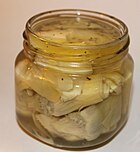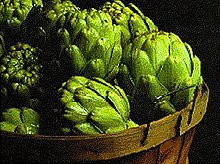| Artichoke | |
|---|---|
 | |
| Scientific classification | |
| Kingdom: | Plantae |
| (unranked): | Angiosperms |
| (unranked): | Eudicots |
| (unranked): | Asterids |
| Order: | Asterales |
| Family: | Asteraceae |
| Subfamily: | Carduoideae |
| Tribe: | Cynareae |
| Genus: | Cynara |
| Species: | C. cardunculus |
| Binomial name | |
| Cynara cardunculus L.[1][2] | |
| Synonyms | |
| Cynara scolymus L.[2] | |

The artichoke is an important winter vegetable in mediterranean cultures. Dansa de la carxofa in Algemesí, Valencian Country.
Contents
|
Cultivation
The origin of artichokes is unknown, though they are said to have come from the Maghreb (North Africa), where they are still found in the wild state; the seeds of artichokes, probably cultivated, were found during the excavation of Mons Claudianus in Egypt during the Roman period.[3] The various names of the artichoke in European languages all ultimately come from Arabic al-kharshuf (approximate spelling).[4] The Arabic term Ardi-Shoki (ارضي شوكي) which means "ground thorny" is a folk etymology of the English name. The cardoon, a naturally occurring variant of the same species, is native to the South Mediterranean, even though it has not been mentioned in extant Classic literature. Artichokes were cultivated in Sicily during the Greek occupation, the Greeks calling them kaktos. In this period the leaves and flower heads, which cultivation had already improved from the wild form, were eaten. The Romans, who called the vegetable carduus received the plant from the Greeks. Further improvement in the cultivated form appear to have taken place in the Muslim period in the Maghreb, although the evidence is inferential only.[5]Globe artichokes are known to have been cultivated at Naples around the middle of the 9th century. Modern scholar, Le Roy Ladurie, in his book Les Paysans de Languedoc has documented the spread of the artichoke:
"The blossom of the thistle, improved by the Arabs, passed from Naples to Florence in 1466, carried by Filippo Strozzi. Towards 1480 it is noticed in Venice, as a curiosity. But very soon veers towards the north-west...Artichoke beds are mentioned in Avignon by the notaries from 1532 onward; from the principle towns they spread into the hinterlands...appearing as carchofas at Cavaillon in 1541, at Chateauneuf du Pape in 1553, at Orange in 1554. The local name remains carchofas, from the Italian carciofo...They are very small, the size of a hen's egg...and are still considered a luxury, a vaguely aphrodisiac tidbit which one preserved in sugar syrup."[6]The Dutch introduced artichokes to England, where they grew in Henry VIII's garden at Newhall in 1530. They were brought to the United States in the 19th century, to Louisiana by French immigrants and to California by Spanish immigrants. The name has originated from the Arabic al-kharshof, through a Northern Italian dialect word, articiocco.[7]
| Nutritional value per 100 g (3.5 oz) | |
|---|---|
| Energy | 220 kJ (53 kcal) |
| Carbohydrates | 10.51 g |
| Sugars | 0.99 g |
| Dietary fiber | 5.4 g |
| Fat | 0.34 g |
| Protein | 2.89 g |
| Thiamine (Vit. B1) | 0.05 mg (4%) |
| Riboflavin (Vit. B2) | 0.089 mg (6%) |
| Niacin (Vit. B3) | 0.111 mg (1%) |
| Pantothenic acid (B5) | 0.240 mg (5%) |
| Vitamin B6 | 0.081 mg (6%) |
| Folate (Vit. B9) | 89 μg (22%) |
| Vitamin C | 7.4 mg (12%) |
| Calcium | 21 mg (2%) |
| Iron | 0.61 mg (5%) |
| Magnesium | 42 mg (11%) |
| Phosphorus | 73 mg (10%) |
| Potassium | 276 mg (6%) |
| Zinc | 0.4 mg (4%) |
| Manganese 0.225 mg | |
| Percentages are relative to US recommendations for adults. Source: USDA Nutrient database | |
Artichokes can be produced from seeds or from vegetative means such as division, root cuttings or micropropagation. Though technically perennials which normally produce the edible flower only during the second and subsequent years, certain varieties of artichoke can be grown from seed as annuals, producing a limited harvest at the end of the first growing season, even in regions where the plants are not normally winter hardy. This means that home gardeners in northern regions can attempt to produce a crop without the need to overwinter plants with special treatment or protection. The recently introduced seed cultivar 'Imperial Star' has been bred to produce in the first year without such measures. An even newer cultivar, 'Northern Star', is said to be able to overwinter in more northerly climates, and readily survive sub-zero temperatures.[8]
Commercial culture is limited to warm areas in USDA hardiness zone 7 and above. It requires good soil, regular watering and feeding plus frost protection in winter. Rooted suckers can be planted each year so that mature specimens can be disposed of after a few years, as each individual plant only lives a few years. The peak season for artichoke harvesting is the spring, but they continue to be harvested throughout the summer, with another peak period in mid autumn.
When harvesting, they are cut from the plant so as to leave an inch or two of stem. Artichokes possess good keeping qualities, frequently remaining quite fresh for two weeks or longer under average retail conditions.
Apart from food use, the Globe Artichoke is also an attractive plant for its bright floral display, sometimes grown in herbaceous borders for its bold foliage and large purple flower heads.
Varieties
- Traditional cultivars (vegetative propagation)
- Green, big: Camus de Bretagne, Castel (France), Green globe (USA).
- Green, medium-sized: Blanca de Tudela (Spain), Argentina, Española (Chile), Blanc d'Oran (Algeria), Sakiz, Bayrampasha (Turkey).
- Purple, big: Romanesco, C3 (Italy).
- Purple, medium-sized: Violet de Provence (France), Brindisino, Catanese,Niscemese (Italy), Violet d'Algerie (Algeria), Baladi (Egypt).
- Spined: Spinoso sardo (Italy), Criolla (Peru).
- Cultivars propagated by seeds
Uses
Cooking
In the US, large globe artichokes are most frequently prepared for cooking by removing all but 5 millimetres (0.20 in) to 10 millimetres (0.39 in) or so of the stem, and (optionally) cutting away about a quarter of each scale with scissors. This removes the thorns on some varieties that can interfere with handling the leaves when eating. Then, the artichoke is boiled or steamed until tender. If boiling, salt can be added to the water, if desired. It may be preferable not to cover the pot while the artichokes are boiled, so that the acids will boil out into the air.Covered, and particularly cut artichokes can turn brown due to the acids and chlorophyll oxidation. If not cooked immediately, placing them in water lightly acidulated with vinegar or lemon juice prevents the discoloration. Leaves are often removed one at a time and the fleshy base part eaten, sometimes dipped in hollandaise, vinegar, butter, mayonnaise, aioli, lemon juice or other sauces, the fibrous upper part of each leaf being discarded; the heart is then eaten when the inedible choke has been discarded after being carefully peeled away from the base. The thin leaves covering the choke are mostly edible.
In Italy, artichoke hearts in oil are the usual vegetable for spring in the 'Four Seasons' pizza (with olives for summer, mushrooms for autumn and prosciutto for winter).[15] In Spain, the more tender younger and smaller artichokes are used. They can be sprinkled with olive oil and left in hot ashes in a barbecue, sauteed in olive oil with garlic, with rice as a paella or sauteed and combined with eggs in a tortilla (frittata). More often cited are the Greek artichokes (à la polita), of which probably the finest examples are to be found on the island of Tinos and in Iria and Kantia,two small villages,in Argolida in the peloponnese of southern Greece.
Often thrown away, the cores of artichoke stems, once the fibrous exterior has been discarded, are perfectly edible and taste like the artichoke heart.
Tea

A tea bag containing artichoke tea
Liquor
Artichoke is the primary flavor of the Italian liqueur Cynar.Medical uses
The total antioxidant capacity of artichoke flower heads is one of the highest reported for vegetables.[16] Cynarin, an active chemical constituent in Cynara, causes an increased bile flow.[17] The majority of the cynarin found in artichoke is located in the pulp of the leaves, though dried leaves and stems of artichoke also contain cynarin.This diuretic vegetable is of nutritional value because of its exhibiting aid to digestion, strengthening of the liver function, gall bladder function, and raising of HDL/LDL ratio. This reduces cholesterol levels, which diminishes the risk for arteriosclerosis and coronary heart disease.[18] Aqueous extracts from artichoke leaves have also shown to reduce cholesterol by inhibiting HMG-CoA reductase and having a hypolipidemic influence, lowering blood cholesterol.[19] Artichoke contains the bioactive agents apigenin and luteolin.[20] Artichoke Cynara scolymus also seems to have a bifidogenic effect on beneficial gut bacteria.[21] Artichoke leaf extract has proved helpful for patients with functional dyspepsia,[22]and may ameliorate symptoms of IBS.[23],[24]







No comments:
Post a Comment